I’ve spent the past few weeks living with Roborock’s new Saros 10R robot vacuum and mop, and I do mean living with it. Roborock’s units tend to occupy a space in my home nearly all year around as I’ve become quite fond of the brand. When it came time to check out one of the latest from them, I was only too excited to do so.
As those of you who own a robot vacuum cleaner can attest, these aren’t gadgets you set up once and forget about. Nor are they the kind you only use every so often. It becomes part of your home, quietly working (sometimes not so quietly) in the background, dealing with dust, pet hair, and all the little messes of daily life.
The Saros 10R isn’t just another “premium robot vacuum.” It aims to fix a problem that bugs a lot of homeowners: cleaning under furniture. And it’s trying to do that while still packing top-tier suction, smart navigation, serious mopping power, and a self-maintaining dock that does most of the dirty work for you.
So, how well does it deliver? Well, here’s a spoiler for you:
Roborock’s Saros 10R glides under furniture most bots can’t reach, scrubs with hot water for a deeper clean, and returns to a dock that empties, washes, and dries. No daily babysitting required.
Design & Build: The Slimmest Heavyweight in the Room
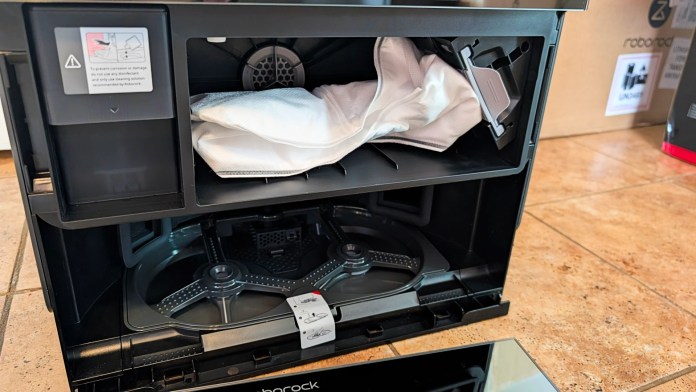

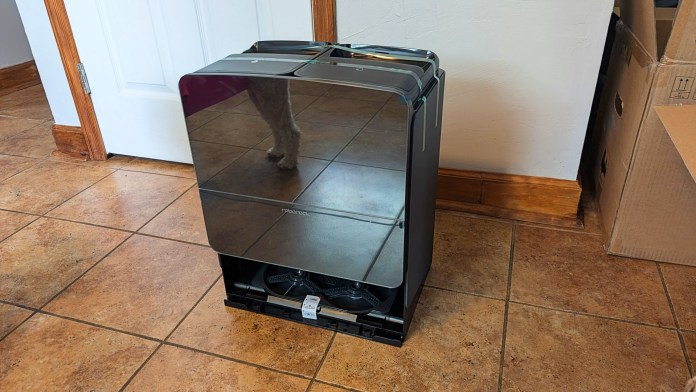
At first glance, the Saros 10R looks like a sleek, understated robot vacuum. But then you notice how low it sits. This thing is only 3.14 inches tall. For context, most robot vacs with LiDAR sit closer to four inches, sometimes more. That difference might sound small, but in practice, it means the Saros can get under sofas, beds, and cabinets that are completely off-limits to the competition.
Sure, many robot vacuums can get underneath a lot of furniture. But the profile here is so thin I realized immediately that it was going to get into places others haven’t. Given these spots are obviously not high-traffic areas, they aren’t going to be all that dirty. Nevertheless, dust and dander, and stuffing from my dog’s toys inevitably find their way under the coffee table. A table, as it turns out, is one that other robots don’t even bother with.
Roborock pulls this off by ditching the traditional LiDAR turret that sticks up like a periscope on most bots. Instead, they’ve gone with a fully integrated StarSight 2.0 system that combines solid-state LiDAR, a 3D ToF sensor, and an RGB camera into a flat housing. It’s a clever design choice that solves a real-world problem without sacrificing navigation.
Build quality feels rock solid. The robot itself is weighty at 9 pounds, with a premium finish that doesn’t scream “plastic appliance.” It’s got all the hallmarks of a Roborock unit and I can pretty much point their stuff out of a lineup at this point. The dock, on the other hand, is a beast at nearly 20 inches tall, with a mirrored glass surface that’s more living room furniture than tech gadget. It’s big, but it’s trying hard to look good or at least unobtrusive.
One minor nitpick: cord management at the dock could be better. For a device that feels so premium, the way the power cord snakes out of the back feels like an afterthought. These cords are thick but there has to be a better way to route things that still feels universal.
The 10-in-1 Dock: Automation, Elevated
The dock is a charging base, sure, but it’s a full-service cleaning assistant. Roborock calls it the “10-in-1 Multifunctional Dock 4.0,” and honestly, that’s not hyperbole. Here’s what it does:
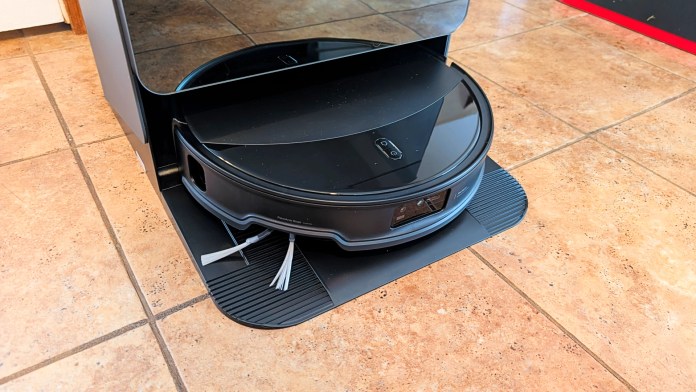
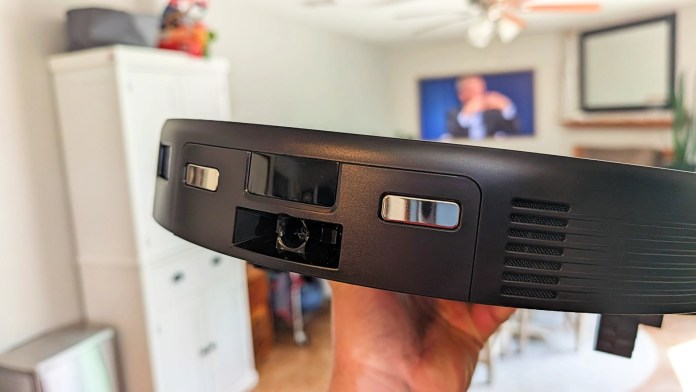
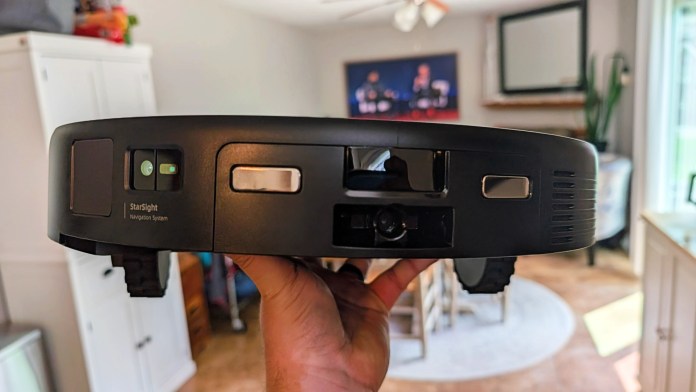
- Auto empties the robot’s dustbin
- Auto washes mop pads with hot water (up to 176°F)
- Auto dries mop pads with warm air
- Auto refills the robot’s water tank
- Auto drains dirty water into a separate tank
- Dispenses detergent automatically
- Detects when mops are still dirty and rewashes them
- Self-cleans the mop washing tray
- Supports fast charging (full in 2.5 hours)
- Comes in a plumbing-ready variant for direct water connection
It’s designed to minimize your involvement. You’re not emptying dustbins every other day or washing filthy mop pads by hand. In my experience, it mostly succeeds. The mop washing is especially satisfying because it actually uses hot water, which feels like a step up from the lukewarm rinses some competitors offer.
That said, you’re trading daily robot maintenance for periodic dock maintenance. You’ll need to refill detergent, empty the dirty water tank, and occasionally clean the dock’s tray. It’s a good trade, but maybe worth reminding some that there is some hands-on stuff that comes with the experience.
Navigation & Obstacle Avoidance: Great Vision, Room for Smarter Reactions
The Saros 10R’s StarSight 2.0 system is doing a lot of heavy lifting. It combines:
- Dual solid-state LiDAR transmitters
- 3D ToF sensors for depth perception
- An RGB camera for object recognition
- Side-mounted VertiBeam sensors for lateral obstacle detection
- A front-mounted LED headlight for dark areas
In controlled tests, and on paper, it’s really quite impressive. It recognizes over a hundred object types, navigates complex layouts, and even has a pet-friendly mode that pauses the main brush near your furry friends.
But in my real-world home, it’s not quite perfect. Dangling cords still trip it up occasionally. It sees them, but its avoidance strategy sometimes involves bumping into them anyway. For furniture legs, shoes, and random clutter, it does great. But power cords? Still a work in progress.
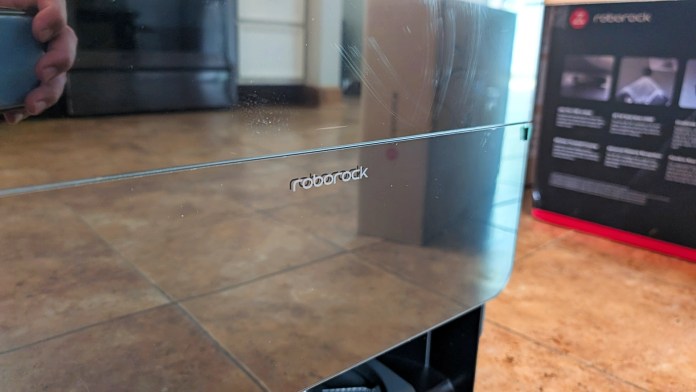
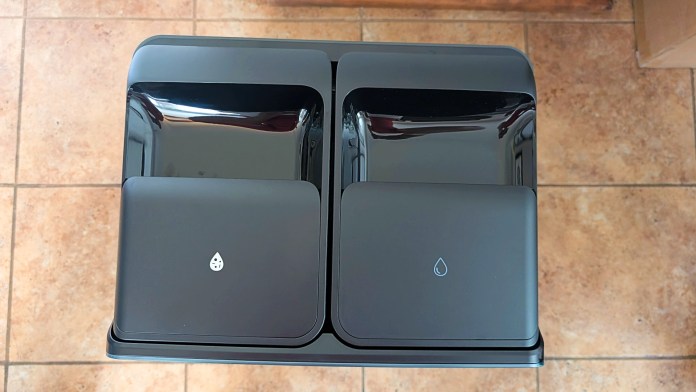
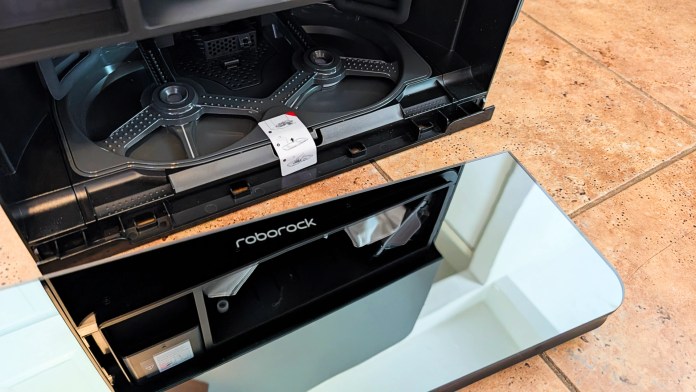
That said, it never fully tangled itself, and it has yet to chew up or mangle a cable; it just needs a little software refinement to be truly flawless. I’ve got some weird pockets in my home that tend to trip up most robots like this so I cannot say it’s exclusive to this model or Roborock in general. Between furniture legs, corners, and cords, things are admittedly tricky. Having said that, I wish I didn’t have to babysit things in the first runs.
We’ve come an incredibly long way over the years so I am optimistic that this sort of thing is figured out in a generation or two. I’d love to shrink the size of one particular “no-go” zone.
Cleaning Performance: Where the Hardware Shines
Vacuuming Power & Hair Management
The headline figure here is 20,000 Pa of suction. That’s intense. In practical terms, it means the Saros 10R doesn’t flinch at dust, debris, or pet hair. It picks up what lesser robots leave behind, especially on carpets. It is rather surprising at how things have advanced in terms of suction over the years.
A decade ago I was of the opinion that there’s no way these types of things could be worth their price. Then I used a few of them and saw how effective they were. And it’s only gotten better.
The DuoDivide anti-tangle brush system is a welcome design choice for pet owners. Two parallel rollers with spiral blades direct hair toward the dustbin while avoiding tangles. I haven’t had to clean the brush manually once. To be fair, my dog doesn’t shed but its toys have strings and stuffing that might get backed up on other vacuums.
Edge cleaning is also strong thanks to the extendable FlexiArm side brush, which physically reaches out to clean corners most bots miss. It’s a small feature, but that extra inch or so under the counter is where some of the most problematic dust hides.
Mopping with Purpose
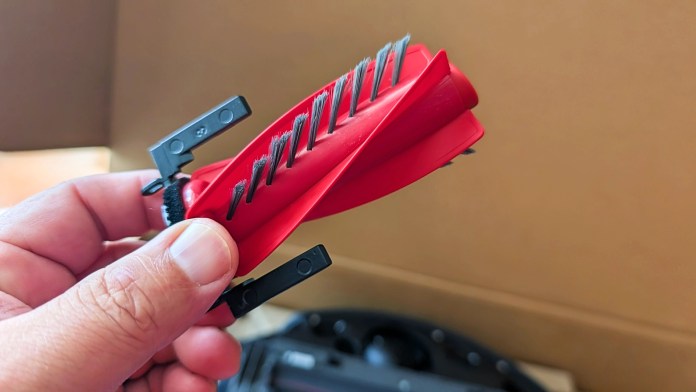
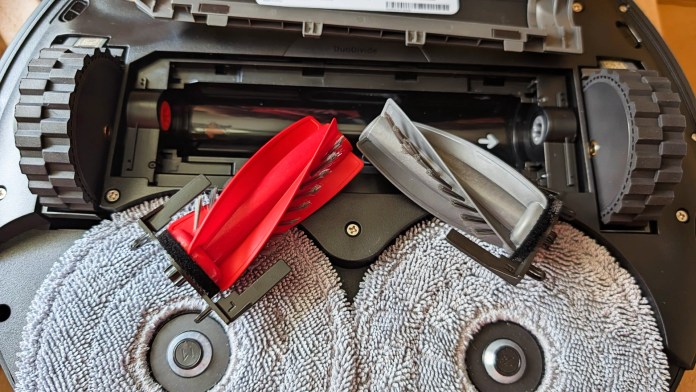

Mopping isn’t an afterthought here. It really feels like a true 2-in-1 device instead of a robot vacuum cleaner that also happens to wet and wipe floors. The Saros 10R uses dual spinning mop pads with enough pressure to scrub away dried stains. The FlexiArm Riser Mop extends to get right up to edges and corners, and seemingly lives up to Roborock’s claim of 0mm clearance along walls.
A huge plus is the hot water mop washing at the dock. Not only does it improve hygiene, but the bot also uses warm water for mopping the floors themselves, which genuinely lifts grime better than cold water.
A word of caution: if you set the robot to vacuum carpets first, it might start mopping hard floors without washing the pads in between. That’s a mess waiting to happen.
Adaptability & Day-to-Day Usage
What really makes or breaks a robot vacuum (or any device) for me isn’t just the spec sheet but how well it blends into my daily routine without needing constant monitoring. The Saros 10R gets a lot of this right. Its design feels purpose-built for the kinds of homes that give most robot vacuums a hard time: places with a mix of hardwood, rugs, thresholds, and way too much furniture with low clearance.
That ultra-thin profile is not a gimmick. I’ve watched it confidently slide under my living room sofa, a spot no other robot has dared to venture, and come back out without getting stuck or confused. That alone feels like a victory, if not at least a step above others.
But it’s not just about slipping under furniture and going whether others can’t. It does a better job of getting from one place to another, especially when the surface changes. The robot’s AdaptiLift chassis is constantly working in the background, adjusting its height as it transitions from hardwood to rugs, then onto thicker carpets.
You can tell the sensors are dialed in because it never drags its mopping pads across carpets by mistake (assuming the software is behaving), and it can lift itself up to tackle thresholds up to 1.57 inches. For most homes, that means it moves freely without you having to intervene, though I did notice it hesitates a bit more with older, taller transitions between rooms.
My home has gone through a number of flooring changes over the years and things are not flush across the entire first floor. This sometimes leads to vacuums that struggle to get from one area to another in the first pass. And while the 10R might have to give it a second attempt, it’s still one of the better performers I’ve seen in this category.
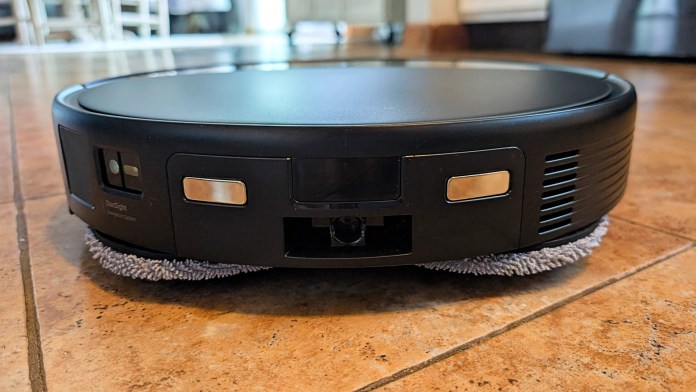
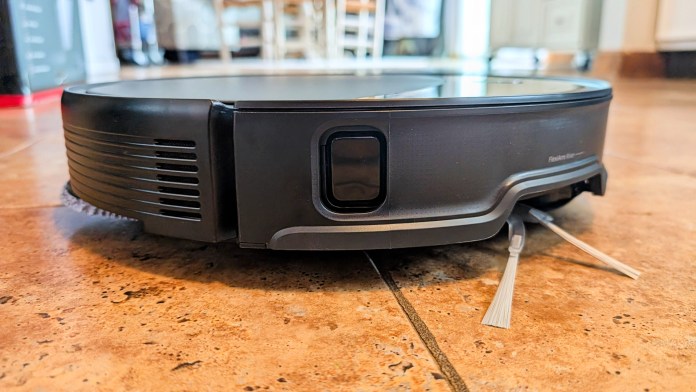

Day-to-day interaction is refreshingly low-maintenance. Thanks to the 10-in-1 dock, I’m not emptying dustbins or scrubbing mop pads manually. The robot leaves its base ready to go, does its thing, and returns to clean itself up.
The hot water mop washing feels like overkill in the best way but it’s reassuring to know it’s not just smearing yesterday’s dirt around. That said, you do still have to keep an eye on consumables like detergent and make sure to empty the dirty water tank once in a while. The tradeoff is clear: less daily effort, more periodic upkeep. The occasional interaction is nothing compared to the time and effort it would be to break out the bucket and mop… and cleaner and water.
One thing I appreciate is how quietly it integrates into daily life. Its low noise level means I can run a full cleaning cycle while working from home without getting distracted. And because of the decent runtime and fast charging, it handles my entire first floor in one go without drama. The only minor friction point is the app which is generally solid; however, there are times when it feels like it’s missing some quality-of-life touches, like task completion notifications or the ability to more easily dictate a cleaning sequence.
Smart Controls & App Experience: Mostly Great, Occasionally Frustrating
Roborock’s app is generally excellent. Map clarity, room editing, no-go zones, cleaning schedules all work as you’d expect. The in-app SmartPlan adapts cleaning routines over time, learning your home’s quirks.
As someone who moves furniture around with seasons or new purchases, it’s nice to know that my vacuum doesn’t have to tiptoe around things, trying to establish a new map each time a box shows up. Living room table is now in the dining room? That’s fine, it will figure it out and revise the map over time.
The native “Hello Rocky” voice assistant is surprisingly responsive, with a 15-meter range. Third-party integrations (Alexa, Google Home, Siri Shortcuts) are present, and Matter support is promised via OTA updates.
My home relies on Google Assistant quite a bit so it would be more convenient if I could ask it to mop the kitchen instead of going into the app and picking the room manually. While I can make the switch to using Rocky, my wife doesn’t love it, and would prefer to be met where she already spends her time.
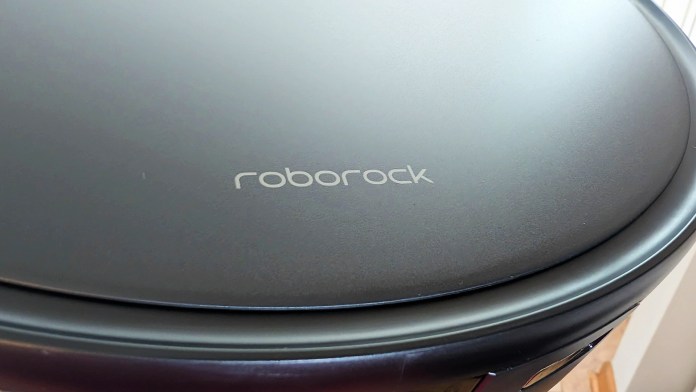
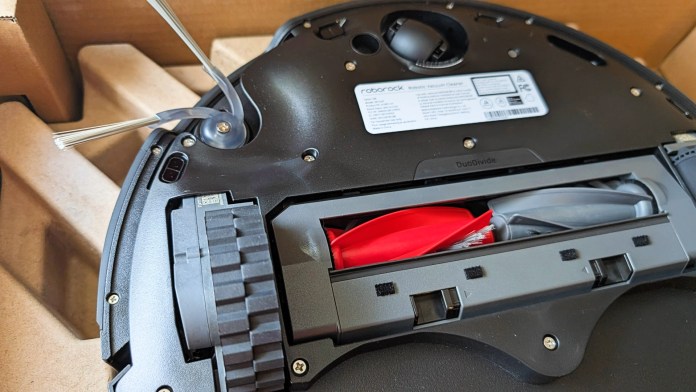

Some QoL changes I might suggest looking into:
- You can’t set a specific cleaning order for rooms.
- No notifications for task completion or mop pad removal.
- Occasional visual glitches (like a strobe effect in live view).
It’s clear the hardware is ahead of the software right now. These ideas aren’t dealbreakers, but they do hold back the “premium” experience a bit. I still prefer the Roborock UI and settings to most brands but there are occasions where I think, “I am surprised this hasn’t been addressed yet.” But, in reality, I largely don’t even think about these things unless I am actively trying to provide critical feedback. Nearly 100% of the time we just ask Google to run the vacuum and go about other chores, or just head to bed for the night.
Noise Levels & Daily Impact
One of my favorite surprises? How quiet this thing is. Officially rated at 65dB, it’s more of a soft whoosh than a whine, making it easy to live with during daily operation. Factor in the quiet hours for when emptying the dirt and dust, and this thing barely registers in the background.
Battery Life & Efficiency
The Saros 10R packs a 6400mAh battery, good for up to three hours of runtime. It can clean up to 4,198 square feet on a single charge. More importantly, it recharges in just 2.5 hours which is far quicker than most rivals.
In daily use, it easily handled my 900-square-foot downstairs without needing a recharge. The fast “charge and resume” feature is the cherry on top. I never have to wonder if there’s going to be enough juice to get the job done, even if I am tasking it twice in the same day.
Value & Who Should Buy It
At $1,599.99, this is a serious investment. But if your home presents the challenges the Saros 10R is designed to tackle, like lots of furniture, heavy pet shedding, a mix of carpets and hard floors, it absolutely earns its keep.
If you live in a simple, open space with no pets and no hard-to-reach areas, you’re maybe paying for features you won’t use. Roborock’s cheaper models would suit you fine.
The 1-year warranty feels a little skimpy for the price, though extended coverage is available. Given the complexity of this system, I’d recommend it. Maybe it’s just me, but whenever a brand is willing to stand behind its products a little longer, I find that to be worth some of the cost. I’d love to see two years for select models in the Roborock lineup, perhaps offer that to a specific series or two.

Awarded to products with an average rating of 3.75 stars or higher, the AndroidGuys Smart Pick recognizes a balance of quality, performance, and value. It stands out in design, innovation, and user experience, delivering great functionality at a competitive price.
Final Thoughts: A Near-Miss Masterpiece
At the end of the day, the Roborock Saros 10R feels like the kind of product that’s inching us closer to what these robot vacuums have always promised: a hands-off cleaning experience that actually works.
It’s not just a spec sheet flex or a flashy dock; it’s thoughtfully designed hardware that solves real-world problems, like getting under almost all of your furniture and keeping your mop pads genuinely clean. Paired with software that, while not flawless, is well ahead of most of the competition, and you’ve a winner.
It’s not cheap, and it’s definitely not for everyone. But if you’ve been burned by clunky bots in the past or you’ve just resigned yourself to vacuuming under the couch by hand, this one might change your mind. If you can find it on sale, or with a limited-time promotion, I’d hop all over it.
For homes that need a little more help and homeowners who value a little less hassle, the Saros 10R hits a very sweet spot. And while I’d love to see Roborock double down on a longer warranty and refine a few software quirks, there’s no question this thing earns its place in my home.